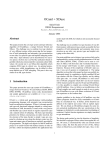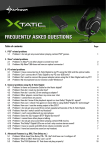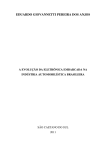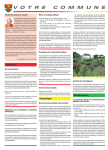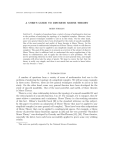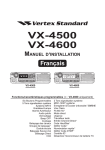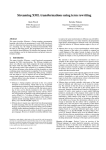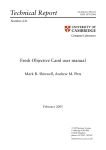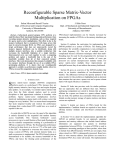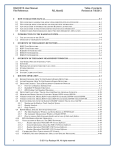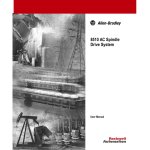Download Alain Frisch. OCaml + XDuce.. ICFP 2006
Transcript
OCaml + XDuce
Alain Frisch
INRIA Rocquencourt
Alain.Frisch@inria.fr
Abstract
The challenge was to combine two type checkers of very different natures while preserving as much as possible the best properties
of both (principality and automatic type reconstruction on one side;
very precise types and implicit subtyping on the other side).
Our main guideline was to design a type system which can be
implemented by reusing existing implementations of OCaml and
CDuce [BCF03, Fri04]. (CDuce can be seen as a dialect of XDuce
with first-class and overloaded functions – for the merger with
OCaml, we don’t consider these extra features). Because of the
complexity of OCaml’s type system, it was out of question to reimplement it. The typing algorithm we describe in this paper has been
successfully implemented simply by combining a slightly modified
OCaml type checker with the CDuce type checker, and by adding
some glue code. As a result, OCamlDuce is a strict extension of
OCaml: programs which don’t use the new features will be treated
exactly the same by OCaml and OCamlDuce. It is thus possible
to compile any existing OCaml library with OCamlDuce. Also, we
believe our modifications to the OCaml compiler are small enough
to make it easy to maintain OCamlDuce in sync with future evolutions of OCaml. Our experience so far confirms that: OCamlDuce
was initially developed over OCaml 3.08.3, and then adapted without any problem for each release until the current 3.09.2.
Another guideline in the design of OCamlDuce was that XDuce
programs should be easily translatable to OCamlDuce in a mechanical way. In XDuce, all the functions are defined at the toplevel
and comes with an explicit signature. We can obtain an OCamlDuce program by some minor syntactical modifications (the new
constructions in the language are delimited to avoid grammatical
overloading of notations). Explicit function signatures are simply
translated to type annotations.
The design goals pushed us into the direction of simplicity. We
choose to segregate XDuce values from regular ML values. Of
course, a constructed ML value can contain nested XDuce values,
but from the point of view of ML, XDuce values are black boxes,
and similarly for types. Also, we decided not to have parametric
polymorphism on XDuce types. A type variable can of course be
instantiated to an XDuce type (or to a type which contains a nested
XDuce type), but it is not possible to force a generalized variable to
be instantiated only to XDuce types or to use a type variable within
an XDuce type. The technical presentation introduces a notion of
foreign type variables, but they are nothing more than a technical
device for inferring ground XDuce types.
This paper presents the core type system and type inference algorithm of OCamlDuce, a merger between OCaml and XDuce.
The challenge was to combine two type checkers of very different natures while preserving the best properties of both (principality and automatic type reconstruction on one side; very precise types and implicit subtyping on the other side). Type inference
can be described by two successive passes: the first one is an MLlike unification-based algorithm which also extracts data flow constraints about XML values; the second one is an XDuce-like algorithm which computes XML types in a direct way. An optional preprocessing pass, called strengthening, can be added to allow more
implicit use of XML subtyping. This pass is also very similar to an
ML type checker.
Categories and Subject Descriptors D.3.0 [Programming Languages]: General; D.3.2 [Programming Languages]: Language
Classifications—Applicative (functional) languages
General Terms
Languages
Keywords OCaml, XDuce, CDuce, XML, type inference, regular
expression types
1. Introduction
This paper presents the core type system of OCamlDuce, a merger
between OCaml [L+ 01] and XDuce [Hos00, HP00, HP03, HVP00].
OCamlDuce source code, documentation and sample applications
are available at http://www.cduce.org/ocaml.
OCaml is a widely-used general-purpose multi-paradigm programming language with automatic type reconstruction based on
unification techniques. XDuce is a domain specific and type-safe
functional language adapted to writing transformations of XML
documents. It comes with a very precise and flexible type system
based on regular expression types and a natural notion of subtyping. The basic type-checking primitives for XDuce constructions
are rather involved, but the structure of the type checker is simple:
types are computed in a bottom-up way along the abstract syntax
tree; the input and output types of functions are explicitly provided
by the programmer. The high-level objective of the OCamlDuce
project is to enrich OCaml with XDuce features in order to provide
a robust development platform for applications that need to deal
with XML but which are not necessarily focused on XML.
Overview In Section 2, we give some intuitions about the behavior of OCamlDuce’s type-checker.
The formalization of the type system will be developed by abstracting away from details about XDuce. In Section 3, we introduce an abstract notion of extension (foreign types and foreign operators) and show of XDuce can be seen as an extension. In Section 4, we present the type-system and type inference algorithm for
a calculus made of ML [Mil78, Dam85] plus an arbitrary extension.
The basic idea is to rely on standard techniques for ML type inference. Indeed, we start from a type system which is an instance of
Permission to make digital or hard copies of all or part of this work for personal or
classroom use is granted without fee provided that copies are not made or distributed
for profit or commercial advantage and that copies bear this notice and the full citation
on the first page. To copy otherwise, to republish, to post on servers or to redistribute
to lists, requires prior specific permission and/or a fee.
ICFP’06 September 16–21, 2006, Portland, Oregon, USA.
c 2006 ACM 1-59593-309-3/06/0009. . . $5.00.
Copyright 192
The basic idea of the OCamlDuce type system is to infer XML
types for the inputs and outputs of XML operators. This is done
by introducing internally a new kind of type variables, called XML
type variables. Before proper type-checking starts, each XML operator used in the program is annotated with fresh XML type variables (in subscript position for the inputs, and in superscript position for the outputs):
ML where foreign types are considered as atomic types and foreign
operators are explicitly annotated with their input and output types.
Then we present an algorithm to infer these annotations. This algorithm is described as two successive passes: the first one is a slightly
modified version of an ML type-checker, and the second one is a
simple forward computation on foreign types.
In Section 5, we present a preprocessing pass, called strengthening, whose purpose is to make more programs accepted by the
type system by allowing implicit use of subtyping.
In Section 6, we present other details of the concrete integration
in OCaml. In Section 7, we compare our approach to related works.
let f x =
let y’ = match[y;p]ιι21 (x) in
{{ y’ @ιι53 ,ι4 y’ }}
let z1 =
f {{ [ <a>[] <b>[] <a>[<b>[]] ]ι6 }}
let z2 =
List.map f
[ {{ [ <a>[<a>[]] ]ι7 }};
{{ [ <a>[<c>[]] ]ι8 }} ]
2. An example
In this section, we illustrate the behavior of OCamlDuce’s typechecker on the following code snippet:
let f x = match x with
{{ [ (y::<a>_ | _)* ] }} -> {{ y @ y }}
let z1 =
f {{ [ <a>[] <b>[] <a>[<b>[]] ] }}
let z2 =
List.map f
[ {{ [ <a>[<a>[]] ] }};
{{ [ <a>[<c>[]] ] }} ]
The regular OCaml type-checker is then applied. It gives to each
XML operator an arrow type following the annotations and then
proceeds as usual (generalizes types of let-bound identifiers, instantiates ML type-schemes when an identifier is used, and performs unifications to make type compatible).
For instance, the concatenation operator in our example is given
the type ι3 → ι4 → ι5 , and the type-checker performs the
following unifications: ι2 = ι3 = ι4 (the type for y’), ι1 =
ι6 = ι7 = ι8 (the type for the argument of f). It also produces
the following types for the top-level identifiers:
The example is intended to illustrate the use of the OCaml
type checker to perform a data-flow analysis of XML values, and
also how OCaml features (here, higher-order functions and datastructures) interact with XDuce features.
Double curly-braces {{...}} are used in OCamlDuce only
to avoid ambiguities in the grammar; they carry no typing information. For instance, the symbol @ used for list concatenation in
OCaml is re-used for denote XML sequence concatenation. Similarly, the square brackets [...] are used both to denote OCaml list
literals (whose elements are separated by semi-colons) and XML
sequences literals when used within double curly braces (their elements are separated by whitespace). XML element literals are written in the form <tag>content.
The first line of the program above declares a function f which
consists of an XML pattern matching on its argument, with a
single branch. The XML pattern p = [ (y::<a>_ | _)* ]
extracts from an XML sequence all the elements with a tag <a>
and put them (in order) in the capture variable y. The function is
then used twice, including once indirectly through a call to the
function List.map (from the OCaml standard library) of type
∀α, β.(α → β) → α list → β list. For the purpose of
explaining type-checking, we will rewrite the body of the function
f as:
val f : ι1 → ι5
val z1 : ι5
val z2 : ι5 list
Of course, we must still instantiate the XML type variables with
ground XML types. Each occurrence of an XML operator in the
program gives one constraint on the instantiation. Indeed, we can
interpret each n-ary operator as as n-ary function from XML types
to XML types. If we choose ι1 and ι2 as representatives for their
classes of equivalence modulo unification, the program is:
let f x =
let y’ = match[y;p]ιι21 (x) in
{{ y’ @ιι52 ,ι2 y’ }}
let z1 =
f {{ [ <a>[] <b>[] <a>[<b>[]] ]ι1 }}
let z2 =
List.map f
[ {{ [ <a>[<a>[]] ]ι1 }};
{{ [ <a>[<c>[]] ]ι1 }} ]
from which we read the following constraints:
let f x =
let y’ = match[y;p](x) in
{{ y’ @ y’ }}
ι2
ι5
ι1
ι1
ι1
The y and p parameters of the match operator represent the
capture variable under consideration and the pattern itself.
In OCamlDuce, XML values (elements, sequences, . . . ) and
regular OCaml values are kept apart. An XML value can of course
appear as part of an OCaml value (e.g. the XML elements which
are put into an OCaml list), but an OCaml value cannot appear
within an XML value. The same applies to types: an XML type
can appear as part of a complex OCaml type expression, but the
converse is impossible. XML operators can be applied to XML
values and return new XML values. In the example, we can see
three kind of XML operators: XML literals (no argument), XML
concatenation (two arguments), and XML pattern matching (one
argument).
≥
≥
≥
≥
≥
match[y;p](ι1 )
ι2 @ι2
[ <a>[] <b>[] <a>[<b>[]] ]
[ <a>[<a>[]] ]
[ <a>[<c>[]] ]
In this system, we consider match[y;p] as a function from XML
types to XML types, given by XDuce’s type inference algorithm for
pattern matching. Similarly, the operator @ is now interpreted as a
function from pair of types to types.
The set of constraints generates dependencies between variables. We say that a variable on a left-hand side of a constraint
depends on variables of the right-hand side. In our example, the
graph of dependencies between variables is acyclic. In this case,
we can topologically order the variables and find the least possible ground XML type for each of them: we assign to a variable the
193
union of all its lower bounds. In the example, we will thus compute
the following instantiation:
ι1
ι2
ι5
=
=
=
let z3 = f z1
Without the preprocessing pass mentioned above, this line
would force the OCaml type-checker to unify ι1 and ι5 . The preprocessing pass actually replaces this definition by:
[ R1 ]
match[y;p]([ R1 ]) = [ R2 ]
ι2 @ι2 = [ R2 R2 ]
let z3 = f idιι12
(z1)
11
The type-checker then unifies ι11 with ι5 and ι12 with ι1 ; the
resulting constraint for id is thus:
where R1 is the regular expression
(<a>[]<b>[]<a>[<b>[]])|<a>[<a>[]|<c>[]]]
ι1 ≥ ι5
and R2 is the regular expression
which corresponds to the fact that the output of f can flow back
to its input. We observe that the set of constraints has now a cycle
between variables ι1 , ι5 and ι2 .
Our type-system cannot deal with such a situation. It would
issue an error explaining that the inferred data flow on XML values
has a cycle. The programmer is then required to break explicitly
this cycle by providing more type annotations. For instance, the
programmer could use the same annotation as above on z1:
(<a>[]<a>[<b>[]])|<a>[<a>[]|<c>[]]
Type-checking is over: we have found an instantiation for XML
type variables which satisfies all the constraints. In essence, the
type-checker has collected all the XML types that can flow to
the input of the function, and then type-checked the body of the
function with the union of all these types. In general, the OCaml
type-checker is used to infer the data flow of XML values in the
programs. The way to solve the resulting set of constraints by
forward computation corresponds roughly to the structure of the
XDuce type-checker.
let z1 : {{[ <a>_* ]}} =
f {{ [ <a>[] <b>[] <a>[<b>[]] ] }}
or maybe he will prefer to annotate the input or output type of f.
Implicit subtyping Let’s see what happens if we add an explicit
type constraint for z1:
3. Abstract extension of ML
let z1 : {{[ <a>_* ]}} =
f {{ [ <a>[] <b>[] <a>[<b>[]] ] }}
The previous section explained the behavior of OCamlDuce’s type
checker on a example. It should be clear from this example that
the type system is largely independent of the actual definitions of
values, types, patterns and operators from XDuce and could be
applied to other extensions of OCaml as well. In this section, we
will thus introduce an abstract notion of extension and show how
XDuce fits into this notion. This more abstract presentation should
help the reader to understand the structure of the type checker,
without having to care about the details of XDuce’s type system.
(The type [ <a>_* ] denotes the set of all sequences made of
XML elements with tag <a>.) The algorithm described above will
infer a much less precise type for z2 as well, which is unfortunate. The reason is that the OCaml type-checker unifies ι5 with
[ <a>_* ]. Basically, the unification-based type system forgets
about the direction of the data flow. There is some dose of implicit
subtyping in the algorithm, but only for the result of XML operators
(because of the way we interpret them as subtyping - not equality constraints).
In order to address this lack of implicit subtyping, we use a preprocessing pass whose purpose is to detect which sub-expressions
are of kind XML and to introduce around them a special unary
XML operator id which behaves semantically as the identity, but
allows subtyping. This preprocessing pass would rewrite the definition for z1 as:
Definition 1. An extension X is defined by:
• a set of ground foreign types T ;
• a subtyping relation ≤ on T , which is a partial order with a
binary least-upper bound operator ;
• a set of foreign operators O;
• for each operator o ∈ O: an arity n ≥ 0 and an abstract
semantics ô : T n → T which is monotone with respect to ≤
on each of its argument.
let z1 : {{[ <a>_* ]}} =
idιι10
(f {{[<a>[] <b>[] <a>[<b>[]]]ι1 }})
9
We use the meta-variable τ to range over ground foreign types.
The foreign operators are used to model both foreign value constructors and operations on these foreign values. Since we are not
going to formalize the dynamic semantics, we don’t need to distinguish between these two kinds of operators.
The monotonicity requirement on the abstract semantics ensures
the completeness of our resolution strategy for constraints (combining the lower bounds for each variable with the operator).
We don’t formalize in this paper the operational semantics of
operators. Instead, we assume informally that it is given and compatible with the abstract semantics.
The variable ι9 will then be unified with ι5 and ι10 with [<a>_*].
The additional constraint corresponding to the id operator is thus
simply:
[ <a>_* ] ≥ ι5
which is satisfied by the same instantiation for ι5 as in the original
example. As a consequence, the type for z2 is not changed.
The preprocessing pass is quite simple. It consists of another
run of the OCaml type-checker, where all the XML types are
considered equal. This allows to identify which sub-expressions are
of kind XML. Section 5 describes this pass formally.
XDuce as an extension Now we show how XDuce features can
be seen as an extension. We consider here a simple version of
XDuce, with the following kind of expressions: element constructor a[e] (seen as a unary operator), empty sequence (), concatenation e1 , e2 , and pattern matching match e with p → e | . . . | p →
e. OCamlDuce is actually built on CDuce, which considers for
instance XML element constructors as ternary operators (the tag
and a specification for XML attributes are also considered as arguments).
Breaking cycles The key condition which allowed us to compute
an instantiation for XML type variables in the example was the
acyclicity of the constraints. As we will see in Section 4, the
acyclicity condition corresponds to the structure of the XDuce’s
type checker, which does not try to infer argument and result types
for recursive functions. Of course, this acyclicity property does not
always hold. For instance, let us extend the original example with
the following definition:
194
quences of characters (hence string regular expression types and
patterns), etc.
The meta-variable p ranges over XDuce patterns. We don’t
need to recall here what they are. We just need to know that for
any pattern p we can define an accepted type p, a finite set of
capture variables Var(p), and for any type τ and any variable x in
Var(p), a type match[x; p](τ ) (which represents the set of values
possibly bound to x when the inspected value is in τ and the pattern
succeeds).
Here is the formal definition of an extension X for XDuce. The
set of ground foreign types T is the set of regular XML tree languages, that is XDuce types quotiented by the equivalence induced
by the subtyping relation (types with the same set-theoretic interpretation are considered equal). The subtyping relation ≤ directly
comes from XDuce. The least-upper bound operator corresponds
to XDuce’s union type constructor (usually written |). We use the
following families of foreign operators:
4. Type system
In this section, we present a type system and a type inference
algorithm for a fixed extension X. This section and the following
one do not depend on a particular extension X. Our language will
be the kernel of an ML-like type system, enriched with types and
operators from the extension X.
Types and expressions The syntax of types and expressions is
given in Figure 1. We use a vector notation to represent tuples. E.g.
t stands for an n-tuple (t1 , . . . , tn ).
We assume a set of ML type constructors, ranged over by the
meta-variable P. Each ML type constructor comes with a fixed arity
and we assume all the types to be well-formed with respect to these
arities. The arrow → is considered as a distinguished binary type
constructor for which we use an infix and right-associative syntax.
We assume two infinite families of type variables and foreign
type variables, respectively ranged over by the meta-variables α
and ι. Let us emphasize that a foreign type variable cannot appear
within a ground foreign type τ . In an expression ∃α.e, the type
variable α is bound in e. Expressions are considered modulo αconversion of bound type variables. The construction ∃α.e thus
serves to introduce a fresh type variable α to be used in a type
annotation somewhere in e.
Foreign operators are annotated with the type of their arguments
(in subscript position) and of their result (in superscript); the number of type arguments is assumed to be coherent with the arity of
the foreign operator. However, in practice, the source language does
not include the annotations: they are automatically filled with fresh
foreign type variables by the compiler (we also use this convention in this paper for some examples). Putting the annotations in
the syntax is just a way of simplifying the presentation. The main
technical contribution of the paper is an algorithm to infer ground
foreign types for the foreign type variables.
• a unary operator for each XML label a, a unary operator;
• a binary operator corresponding to the concatenation;
• a constant operator corresponding to the empty sequence;
• for any pattern p and variable x in Var(p), a unary operator
written match[x; p] (its semantics is to return the value bound
to x when matching its argument against the pattern p).
The abstract semantics for all these operators follows directly from
XDuce’s theory.
Element constructor, concatenation and the empty sequence
expressions can directly be seen as foreign operators. This is not the
case for a pattern matching match e with p1 → e1 | . . . | pn →
en . We are going to present an encoding of pattern-matching in
terms of operators and normal ML expressions. This encoding is
rather heavy; in practice, the implementation deals with pattern
matching directly.
First, we define the translation p → e of a single branch where
Var(p) = {x1 , . . . , xn } as the expression:
λx.
let x1 = match[x1 ; p]x in
...
let xn = match[xn ; p]x in
e
The ML(X) fragment We call ML(X) the fragment of our calculus where all the foreign types are restricted to be ground. Figure 2 defines a typing judgment Γ e : t for ML(X). It is exactly an instance of the ML type system [Mil78, Dam85] if we see
ground foreign types as atomic ML types and ground-annotated
foreign type operators oττ as built-in ML constants or constructors
(we also introduce explicit type annotation and type variable introduction). We recall classical notions of type scheme, typing environment and generalization. A type scheme is a pair of a finite set
ᾱ of type variables and of a type t, written ∀ᾱ.t. The variables
in ᾱ are considered bound in this scheme. We write σ t if the
type t is an instance of the type scheme σ. A typing environment
is a finite mapping from program variables to type schemes. The
generalization of a type t with respect to a typing environment
Γ, written GenΓ (t) is the type scheme ∀ᾱ.t where ᾱ is the set of
variables which are free in t, but not in Γ.
Then, the translation of match e with p1 → e1 | . . . | pn →
en is defined as:
let x = e in
dispatch[τ1 , . . . , τn ] x x (p1 → e1 ) . . . (pn → en )
where τi = pi and pi = pi \(τ1 . . . τi−1 ) (the restriction
of pi to values which do not match any pattern from an preceding
branch). The \ operator denotes set-theoretic type difference (in
XDuce, it is a meta-operation; in CDuce, it is part of the type algebra). We have used in this translation a new built-in ML constant
dispatch[τ1 , . . . , τn ] of type scheme: ∀α.(τ1 . . . τn ) → α →
(α → β) → . . . → (α → β) → β, which we assume to be present
in the initial typing environment. Its intuitive semantics is to drop
the first argument (it is used only to force the type-checker to verify
that x has type τ1 . . . τn , which corresponds to the XDuce’s
pattern matching exhaustivity condition), and to call the kth functional argument (1 ≤ k ≤ n) on the second argument when k is
the smallest integer such that this argument has type τk .
In principle, the technique described in this paper could be used
to integrate many of the existing extensions to the original XDuce
design (such as attribute-element constraints [HM03] or XML filters [Hos04]) without any additional theoretical complexity. In its
current form, however, OCamlDuce integrates all the CDuce extensions except overloaded functions: XML attributes as extensible records, sequence and tree pattern-based iterators, strings as se-
Type-soundness of the ML(X) fragment We assume that a
sound operational semantics is given for the ML(X) calculus. This
amounts to defining δ-reduction rules for the oττ operators which
are coherent with the abstract semantics for the foreign operators.
Well-typed expressions in ML(X) (in an empty typing environment, or an environment which contains built-in ML operators)
cannot go wrong. We also assume that the operational semantics
for an oττ operator depends only on o, not on the annotations τ , τ .
This allows us to lift the semantics of ML(X) to the full calculus
of Figure 1.
Typing problems A substitution φ is an idempotent function
from types to types that maps type variables to types, foreign type
195
ε ::=
τ
ι
Foreign types:
ground foreign type
foreign type variable
t ::=
P t
α
ε
Types:
constructed
type variable
foreign type
e ::=
x
λx.e
ee
let x = e in e
(e : t)
∃α.e
oεε
Expressions:
program variable
abstraction
application
local definition
annotation
existential variable
foreign operator
Figure 1. Types and expressions
Γ(x) t
Γx:t
Γ, x : t1 e : t2
Γ λx.e : t1 → t2
Γ e1 : t1 → t2
Γ e2 : t1
Γ e1 e2 : t2
Γ e[t0 /α] : t
Γ ∃α.e : t
Γe:t
Γ (e : t) : t
Γ e1 : t1
Γ, x : GenΓ (t1 ) e2 : t2
Γ let x = e1 in e2 : t2
ô(τ ) ≤ τ
Γ oττ : τ1 → . . . → τn → τ
Figure 2. Type system for the ML(X) fragment
Type inference Let us consider a fixed typing problem (Γ, e, t).
We want to find solutions to this problem. Thanks to Lemma 1, we
will split this task into two different steps:
variables to foreign types, ground foreign types to themselves, and
that commutes with ML type constructors. We use a post-fix notation to denote a capture-avoiding application of this substitution to
typing environments, expressions, types or constraints.
A substitution φ1 is more general than a substitution φ2 if φ2 =
φ2 ◦ φ1 1 .(Or equivalently, because substitutions are idempotent:
there exists a substitution φ such that φ2 = φ ◦ φ1 .)
A typing problem is a tuple (Γ, e, t). (Usually, t is a fresh
type variable.) A solution to this problem is a substitution φ such
that Γφ eφ : tφ is a valid judgment in ML(X). We will now
rephrase this definition in terms of a typing judgment on the full
calculus. This judgment Γ X e : t is defined by the same rules as
in Figure 2, except for foreign operators, for which we take:
• find a most-general pre-solution φ0 ;
• instantiate the remaining foreign type variables so as to satisfy
the resulting constraint.
It is almost straightforward to adapt unification-based existing
algorithms for ML type inference (and their implementations) to
compute a most general pre-solution if there exists a pre-solution,
or to report a type error otherwise. Indeed, the typing judgment X
is very close to a normal ML type system. In particular, it satisfies
a substitution lemma: if Γ X e : t, then Γφ X eφ : tφ for any
substitution φ.
Of course, if the typing problem has no pre-solution, it has no
solution as well. For the remaining of the discussion, we assume
given a most general pre-solution φ0 . Let us write V for the set of
foreign type variables that appear in (Γφ0 , eφ0 , tφ0 ) and C0 for the
constraint C(eφ0 ).
A solution to the typing problem is in particular a pre-solution.
As a consequence, a substitution φ is a solution if and only if φ =
φ ◦ φ0 and if it maps foreign type variables in V to ground foreign
types in such a way that C0 φ. The “minimal” modification we
need to bring to φ0 to get a solution is to instantiate variables in
V so as to validate C0 . Formally, we define a solvent as a function
ρ : V → T such that C0 ρ. To any solvent ρ, we can associate a
solution φ defined by tφ = tφ0 ρ and any solution is less general
than the solution obtained this way from some solvent. In particular,
a solution exists if and only if a solvent exists. So we are now
looking for a solvent.
We won’t give a complete algorithm to check for the existence
of a solvent. This would lead to difficult constraint solving problems which might be undecidable (this of course depends on the
extension X). Even if they are decidable for a given extension,
they might be intractable in practice and so we prefer to stick to
our design guideline that type inference shouldn’t be significantly
more complicated than both ML type inference and XDuce-like
type inference. XDuce computes in a bottom-up way, for each subexpression, a type which over approximates all the possible outcomes of this sub-expression. The basic operations and their typing discipline corresponds respectively to our foreign operators and
their static semantics. XDuce’s type system uses subsumption only
Γ X oεε : ε1 → . . . → εn → ε
Typing environment and type schemes that are used in the judgment
X are allowed to contain foreign type variables. We say that φ
is a pre-solution to the typing problem (Γ, e, t) if the assertion
Γφ X eφ : tφ holds. Of course, the new rule for foreign operators
forgets the constraints that relates the input and output types of
foreign operators. In order to ensure type soundness, we must also
enforce these constraints.
Formally, we define a constraint C as a finite set of annotated
foreign operators oεε. We write C if all the elements of C are of
the form oττ with ô(τ ) ≤ τ . For an expression e, we collect in a
constraint C(e) all the instances of foreign operators oεε that appear
in e. Note that for any substitution φ, we have C(e)φ = C(eφ).
We are ready to rephrase the notion of solution.
Lemma 1. A substitution φ is a solution to the typing problem
(Γ, e, t) if and only if the following three assertions hold:
• Γφ, eφ and tφ do not contain foreign type variables;
• φ is a pre-solution to the typing problem;
• C(eφ).
Type soundness Type soundness for our calculus is a trivial consequence of the type soundness assumption for the ML(X) fragment. Indeed, we can see a solution φ to a typing problem (Γ, e, t)
as an elaboration into a well-typed program in this fragment.
usual, the symbol ◦ denotes the composition of functions. The composition of two substitutions is not in general a substitution.
1 As
196
Partial operators The foreign operators were assumed to be total.
This means they should apply to any foreign value. We can simulate
partial operators by adding a new top element to the set of
ground foreign types T , and by requiring the abstract semantics
of operators to be such that whenever an argument is , the result
is also . Since the typing algorithm infers the smallest solvent for
foreign type variables, we can simply look at it and check that no
foreign type variable is mapped to .
when necessary (e.g. to join the types of the branches of a pattern
matching, or when calling a function). So we can say that XDuce
tries to compute a minimal type for each sub-expression, by applying basic type-checking primitives. We will do the same, and to
make it work, we need some acyclicity property, which corresponds
to the bottom-up structure of XDuce’s type checker.
C
Definition 2. Let C be a constraint. We write ι1 ι2 if C contains
an element oεε such that ι2 = ε and ι1 appears in ε. We say that C
is acyclic if the directed graph defined by this relation is acyclic.
5. Strengthening
Our type inference algorithm only deals with the case of an
acyclic constraint C0 (this condition does not depend on the particular choice of the most general pre-solution). If the condition is not
met, we issue an error message. It is not a type error with respect to
the type system, but a situation where the algorithm is incomplete.
As we mentioned above, we can see the type system for the calculus
as an elaboration into its ML(X) fragment, which immediately
gives type soundness.
In this section, we consider another elaboration from the calculus into itself. Namely, this elaboration is intended to be used as a
preprocessing pass (rewriting expressions into expressions) in order to make the type system accept more programs. We call this
elaboration procedure strengthening.
The issue addressed by strengthening is a lack of implicit subsumption in our calculus. We already hinted at this issue in Section 2. We will now give more examples.
Remark. The acyclicity criterion is of course syntactical (it does
not depend on the semantics of constraints but on their syntax), but
it is not defined in terms of a specific inference algorithm. Instead,
it is defined in terms of the most-general pre-solution of an ML-like
type system. In particular, it does not depend on implementation
details such as the order in which sub-expression are type-checked.
Below we furthermore assume that C0 is acyclic. We define the
function ρ0 : V → T by the following equation:
G
ερ0 ) | oιε ∈ C0 }
∀ι ∈ V. ιρ0 = {ô(
Subsumption missing in action We consider the typing problem
(Γ1 , e1 , β) where Γ1 = {x : τ1 , y : τ2 , f : ∀α. α → α → α} and
e1 = f x y. It admits a solution if and only if τ1 = τ2 . In a system
with implicit subtyping, we might expect to give type τ = τ1 τ2
to both x and y, so that the application succeeds and the result type
is τ .
Similarly, the expression (λx.x : τ1 → τ2 ) is not well-typed
even if τ1 ≤ τ2 (unless τ1 = τ2 ).
The acyclicity condition ensures that this definition is well-founded
and yields a unique function ρ. Furthermore, this function is a
solvent if and only if the typing problem has a solution. To check
this property, only constraints whose right-hand side is a ground
foreign type need to be considered:
A naive solution Let us see how to implement the amount of
implicit subtyping we need to make these examples type-check.
The following rule could be a reasonable candidate as an addition
to the type system (we write ≤ for the new typing judgment):
(1) ∀oτε ∈ C0 . ô(
ερ 0 ) ≤ τ
Also, any other solvent ρ is such that:
τ ≤ τ
Γ ≤ e : τ
Γ ≤ e : τ ∀ι ∈ V. ιρ0 ≤ ιρ
In other words, under the acyclicity condition, we can check in a
very simple way whether a given typing problem has a solution,
and if this is the case, we can compute the smallest solvent (for the
point-wise extension of the subtyping relation). This computation
only involves one call to the abstract semantics for each application
of a foreign operator in the expression to be type-checked.
A concrete way to see this rule is that any subexpression e can
be magically transformed to the application idιι21 e , where id is a
ˆ ) = τ and ι1 , ι2 are
distinguished foreign operator such that id(τ
fresh foreign type variables.
The type system extended with this rule would accept the examples given above to illustrate the lack of implicit subsumption. However, this rule as it stands would add a lot of complexity to the type inference algorithm. As a matter of fact, the type
system would not admit most-general pre-solutions anymore. We
can see this on a very simple example with the typing problem
({x : τ }, x, α). We could argue that a more liberal definition of
being more-general should allow some dose of subtyping. So let us
consider the more complex example Γ3 = {f : ∀α. α → α → α}
and e3 = λx.λy.λz.λg.g (f x y) (f x z). In ML, the inferred type
scheme would be ∀α, β.α → α → α → (α → α → β) → β
which forces the first three arguments to have the same type. But
if the arguments turn out to be of a foreign-type, another family of
types for the function is possible, namely ∀β.τ1 → τ2 → τ3 →
((τ1 τ2 ) → (τ1 τ3 ) → β) → β, and these types cannot be
obtained as instances of the ML type scheme above.
Remark. In some cases, it is possible to find manifest type errors
even when the constraint is not acyclic. In practice, the computation of ρ0 , the verification of (1), and the check for acyclicity can
be done in parallel, e.g. with a deep-first graph traversal algorithm.
It can detect some violation of (1) before a cycle. In this case, we
know that the typing problem has no solution, and thus a proper
type error can be issued.
Manually working around the incompleteness When the algorithm described above infers a cyclic constraint, it cannot detect
whether the typing problem (Γ, e, t) has a solution or not. However, we have the following property. If a solution φ exists, then
we can always produce an expression e by adding annotations to e
such that the algorithm succeeds for the typing problem (Γ, e , t)
and that φ is equivalent (for the equivalence induced by the moregeneral ordering) to the solution φ0 computed by the algorithm.
In other words, even if the algorithm is not complete (because
of the acyclicity condition) and makes a choice between mostgeneral solutions (the smallest one for the subtyping relation), for
any solution to a typing problem, the programmer can always add
annotations so that the algorithm infers this very solution (or an
equivalent one).
A practical solution We will now describe a practical solution.
Instead of modifying the type system by adding a new subsumption
rule, we will formulate the extension as a rewriting preprocessing
pass. The rewriting consists in inserting applications of the identity
foreign operator id. The challenge is then to choose which subexpressions e should be rewritten to id e . If we had an oracle
197
The relaxed condition is: There must be no cycle in the constraint except maybe cycles whose edges are all produced by the
id operator.
To illustrate the usefulness of the relaxed condition, let us consider the expression e = fix(λg.λx.f c (g x)) with Γ = {fix :
∀α.(α → α) → α, f : ∀α.α → α → α, c : τ }. The strengthening pass builds a principal typing derivation for e in a type algebra where all the foreign types are identified. Here is such a
derivation, where we write for foreign types and t = α → ,
Γ = Γ, g : t, x : α (we collapse rules for multiple abstraction and
application):
to tell us so, the composition of the rewriting pass and the type
system of Section 4 would be equivalent to the type system ≤ .
Unfortunately, we don’t have such an oracle. We could try all the
possible choices of sub-expressions, and this would give a complete
type-checking algorithm for the type system ≤ .
We prefer to use a computationally simpler solution. We also
expect it to be simpler to understand by the programmer. The idea
is to use an incomplete oracle. The oracle first runs a special version
of an ML type-checker on the expression to be type-checked. This
type-checker identifies all the foreign types together. The effect is
to find out which sub-expressions have a foreign type in a principal
derivation, that is, which sub-expression have necessarily a foreign
type in all the possible derivations. The preprocessing pass consists
in adding an application of the identity operator above all these
sub-expressions and only those.
The important point here is that the oracle may be overly conservative. Let us consider a type variable which has been generalized
in the principal derivation. In a non-principal derivation, it could
have been instead instantiated to a foreign type. If this derivation
had been considered instead of the principal one, the preprocessing
pass would have added more applications of the identity operator.
Maybe this would have been necessary in order to make the resulting expression type-check. An example is given by the expression
let h = e3 in (h : τ1 → τ2 → τ3 → ((τ1 τ2 ) → (τ1 τ3 ) →
t) → t) where e3 is from the example above. Here, the preprocessing pass succeeds but does not change the expression because
no sub-expression has a foreign type in the principal type derivation. The type-scheme inferred for h is a pure ML type-schema,
which makes the type-system subsequently fail on the expression.
We believe that this restriction of the ≤ system is reasonable. It
can be implemented very simply by reusing the same type-checker
as in Section 4 in a different mode (where all the foreign types can
be unified). The simple examples at the beginning of this section
are now accepted. Indeed, the preprocessing pass transforms the
expressions to f (id x) (id y) and ((λx.id x) : τ1 → τ2 )
respectively. This allows the type system to use subtyping where
needed.
Γ f : → → Γ g : t
Γ x : α
Γ c:
Γ gx:
Γ f c (g x) : Γ fix : (t → t) → t
Γ λg.λx.f c (g x)) : t → t
Γe:α→
On this principal derivation, we observe three sub-expressions
of a foreign type. Accordingly, strengthening introduces three instances of the id operator and thus rewrites the expression to:
e = fix(λg.λx.idιι21 (f (idιι43 c) (idιι65 (g x))))
The type-checker which is then applied performs some unifications: ι1 = ι4 = ι6 , ι2 = ι5 , ι3 = τ . We can for instance assume that the computed most-general pre-solution maps ι4 and ι6
to ι1 and ι5 to ι2 . The first and third instances of the id operator
C0
C0
ι2 and ι2 ι1 . Strictly
in e thus generate the dependencies ι1 speaking, the constraint is cyclic, but we can break the cycle simply by unifying ι1 and ι2 . The smallest solvent is then given by
ι1 ρ = τ . We would have obtained the same solution if we had applied the type-checker directly on e without the strengthening pass.
In this example, strengthening is useless and the relaxed acyclicity
condition is just a way to break a cycle introduced by strengthening.
We can easily imagine more complex examples where strengthening is really necessary but introduces cycles that can be broken by
the relaxed condition.
Properties The strengthening pass cannot transform a well-typed
program into an ill-typed one. Note, however, that it might break
the acyclicity condition if it was already met. See below for a way
to relax the acyclicity condition.
Also, if strengthening fails, the typing problem has no presolution (for the typing judgment ), and thus no solution. However, it is not true that if it succeeds, a pre-solution necessarily
exists (for the new program where applications of the id operators have been added). As an example, let us consider the situation
where Γ = {x : τ1 → τ1 , y : τ2 → τ2 , f : ∀α. α → α → α}
and e = f x y. The preprocessing succeeds, because all the foreign types are considered equal but does not touch the expression
(because no sub-expression has a foreign type in a principal typing derivation). Still, the next pass of the type inference algorithm
attempts to unify the types τ1 and τ2 and thus fails.
6. Integration in OCaml
We have described a type system for basic ML expressions. Of
course, OCaml is much more than an ML kernel. We found no
problem to extend it to deal with the whole OCaml type system, including recursive types, modules, classes, and other fancy features.
The two ML-like typing passes (the one used during strengthening
and the one using for the real type-checking) are done on whole
compilation units (in the toplevel, they are done on each phrase).
The information from the compilation unit interface (the .cmi
file) is integrated before checking the acyclicity condition. Indeed,
this information acts as additional type annotations on the values
exported by the compilation unit and can thus contribute to obtaining this condition. Also, in addition to type annotations on expressions, OCaml provides several ways to introduce explicit type
informations (and thus obtain the acyclicity condition): datatype
definitions (explicit types for constructor and exception arguments,
record fields), module signatures, type annotations on ML pattern
variables.
Because of its global flow analysis flavor, OCamlDuce’s type
system is much less modular than OCaml’s. In particular, all the
call sites of a function which expects XML values as arguments
can contribute to the result type of the function. In practice, to
alleviate this lack of modularity and to get better error messages,
Relaxing the acyclicity condition Inserting applications of the id
operator can break the acyclicity condition. We can actually relax
this condition to deal with the id operator more carefully. Let us
C
C
consider a constraint C with a cycle ι1 . . . ι1 , such that
all the edges in this cycle come from elements of the form idιι .
Clearly, any solvent ρ such that Cρ will map all the ιi in the
cycle to the same ground foreign type. So instead of considering
the most-general pre-solution and then face a cyclic constraint, we
may as well unify all these ιi first: all the solutions can still be
obtained from this less-general pre-solution.
198
CDuce. The interface is actually quite simple: each monomorphic
OCaml type t is mapped in a structural way to a CDuce type t̂.
A value defined in an OCaml module can be used from CDuce
(the compiler introduces a natural translation t → t̂). Similarly,
it is possible to provide an ML interface for a CDuce module: the
CDuce compiler checks that the values exported by the module
are compatible with the ML-to-CDuce translation of these types
and produces stub code to apply a natural translation t̂ → t to
these values. This CDuce/OCaml interface is used by many CDuce
users and served as a basis to the to_ml and from_ml operators
described in Section 6.
Sulzmann and Zhuo Ming Lu [SL05] pursue the same objective
of combining XDuce and ML. However, their contribution is orthogonal to ours. Indeed, they propose a compilation scheme from
XDuce into ML such that the ML representation of XDuce values is driven by their static XDuce type (implicit use of subtyping
are translated to explicit coercions). Their type system supports in
addition used-defined coercions from XDuce types to ML types.
However, they do not describe a type inference algorithm for their
abstract specification of a type system and do not study the interaction between XDuce type-checking and ML type inference (XDuce
code can call ML functions but their type must be fully known).
These last points are precisely the issues tackled by our contribution. For instance, our system makes it possible to avoid some
type annotation on non-recursive XDuce functions. Another difference is that in our approach, the XDuce/CDuce type checker and
back-end (compilation of pattern matching) can be re-used without any modification whereas their approach requires a complete
reengineering of the XDuce part (because subtyping and pattern
matching relations must be enriched to produce ML code) and it
is not clear how some XDuce features such as the Any type can
be supported in a scenario of modular compilation. We believe our
approach is more robust with respect to extensions of XDuce and
that the XDuce-to-ML translation can be seen as an alternative implementation technique for XDuce which allows some interaction
between XDuce and ML (the same kind of interaction as what can
be achieved with the CDuce/OCaml interface described above).
The Xtatic project [GP03] is another example of the integration of XDuce types into a general purpose language, namely C#.
Since both C#’s and XDuce’s type checkers operate with bottomup propagation (explicit types for functions/methods, no type inference), the structure of Xtatic type-checker is quite simple. The real
theoretical contribution is in the definition of a subtyping relation
which combines C# named subtyping (inheritance) and XDuce settheoretic subtyping. Since the resulting type algebra does not have
least-upper bounds, the nice locally-complete type inference algorithm for XDuce patterns [HP02] cannot be transferred to Xtatic. In
Xtatic, XDuce types and C# types are stratified, but the two algebras are mutually recursive: XDuce types can appear in class definitions and C# classes can be used as basic items in XDuce regular
expression types. This does not really introduce any difficulty because C# types are not structural. The equivalent in OCamlDuce
would be to allow OCaml abstract types as part of XDuce types,
which would not be difficult, except for scoping reasons (abstract
types are scoped by the module system).
In the last ten years, a lot of research effort has been put into
developing type inference techniques for extensions of ML with
subtyping and other kinds of constraints. For instance, the HM(X)
framework [OSW99] could serve as a basis to express the type
system presented here. The main modification to bring to HM(X)
would be to make foreign-type variables global. Another way to
express it is to disallow constraints in type-schemes (which is what
we do in the current presentation). We have chosen to present our
system in a setting closer to ML so as to make our message more
the programmer should probably give more type annotations than
what it strictly required.
OCaml subtyping OCaml comes with a structural subtyping relation (generated by object types and polymorphic variants subtyping
and extended structurally by considering the variance of ML type
constructors). The use of this subtyping relation in programs is explicit. The syntax is (e : t1 :> t2 ) (sometimes, the type t1 can be
inferred) and it simply checks that t1 is a subtype of t2 . Of course,
the OCaml subtyping relation has been extended in OCamlDuce to
take XDuce subtyping into account. For instance, if τ1 is a XDuce
subtype of τ2 and e has type τ1 list, then it is possible to coerce it
to type τ2 list: (e :> τ2 list).
Crossing the boundary In our system, XDuce values are opaque
from the point of view of ML and XDuce types cannot be identified with other ML type constructors. Sometimes, we need to
convert values between the two worlds. For instance, we have a
foreign type String which is different from OCaml string.
This foreign type conceptually represents immutable sequences
of arbitrary Unicode characters, whereas the OCaml type should
be thought as representing mutable buffers of bytes. As a consequence, we don’t even try to collapse these two types into
a single one. Instead, OCamlDuce comes with a runtime library which exports conversion functions such as Utf8.make:
string -> String, Utf8.get: String -> string
and Latin1.make: string -> Latin1, Latin1.get:
Latin1 -> string. The type Latin1 is a subtype of String:
it represents all the strings which are only made of latin-1 characters (latin-1 is a subset of the Unicode character set). The function
Utf8.make checks at runtime that the OCaml string is a valid
representation of a Unicode string encoded in utf-8.
Similarly, we often need to translate between XDuce’s sequences and OCaml’s lists. For any XDuce type τ , we can easily
write two functions of types [τ ∗] → τ list and τ list → [τ ∗]
(the star between square brackets denotes Kleene-star). Similarly,
we can imagine a natural XDuce counterpart of an OCaml product
type τ1 ×τ2 , namely [τ1 τ2 ], and coercion functions. However, writing this kind of coercions by hand is tedious. OCamlDuce comes
with built-in support to generate them automatically. This automatic system relies on a structural translation of some OCaml types
into XDuce types: lists and arrays are translated to Kleene-star
types, tuples are translated to finite-length XDuce sequences, variant types are translated to union types, etc. Some OCaml types such
as polymorphic or functional types cannot be translated. OCamlDuce comes with two magic unary operators to_ml, from_ml
(both written {: ...:} in the concrete syntax). The first one
takes an XDuce value and applies a structural coercion to it in order to obtain an OCaml value; this coercion is thus driven by the
output type of the operator. The type-checker requires this type
to be fully known (polymorphism is not allowed). Similarly, the
operator from_ml takes an OCaml value and apply a structural
coercion in order to obtain an XDuce value. Since the type of its
input drives its behavior, the type-checker requires this type to be
fully known.
This system can be used to obtain coercions from complex
OCaml types (e.g. obtained from big mutually recursive definitions
of concrete types) to XDuce types, whose values can be seen as
XML documents. This gives parsing from XML and pretty-printing
to XML for free.
7. Related work
The CDuce language itself comes with a typed interface with
OCaml. The interface was designed to: (i) let the CDuce programmers use existing OCaml libraries; (ii) develop hybrid projects
where some modules are implemented in OCaml and other in
199
explicit: our system can be easily implemented on top of existing
ML implementations.
[Dam85]
Luis Manuel Martins Damas. Type assignment in programming
languages. PhD thesis, University of Edinburgh, Scotland,
April 1985.
8. Conclusion and future work
[Fri04]
Alain Frisch. Théorie, conception et réalisation d’un langage
de programmatio n fonctionnel adapté à XML. PhD thesis,
Université Paris 7, December 2004.
[GP03]
Vladimir Gapeyev and Benjamin C. Pierce. Regular object
types. In European Conference on Object-Oriented Programming (ECOOP), Darms tadt, Germany, 2003.
[HFC05]
Haruo Hosoya, Alain Frisch, and Giuseppe Castagna. Parametric polymorphism for XML. In POPL, 2005.
[HM03]
Haruo Hosoya and Makoto Murata. Boolean operations and
inclusion test for attribute-element constraint s. In Eighth
International Conference on Implementation and Application
of Automata, 2003.
[Hos00]
Haruo Hosoya. Regular Expression Types for XML. PhD thesis,
The University of Tokyo, Japan, December 2000.
[Hos04]
Haruo Hosoya. Regular expression filters for XML. In
Programming Languages Technologies for XML (PLAN-X),
2004.
[HP00]
Haruo Hosoya and Benjamin C. Pierce. XDuce: A typed XML
processing language. In Proceedings of Third International
Workshop on the Web and Data bases (WebDB2000), 2000.
[HP02]
Haruo Hosoya and Benjamin C. Pierce. Regular expression pattern matching for XML. Journal of Functional Programming,
13(4), 2002.
[HP03]
Haruo Hosoya and Benjamin C. Pierce. A typed XML processing language. ACM Transactions on Internet Technology,
3(2):117–148, 2003.
[HVP00]
Haruo Hosoya, Jérôme Vouillon, and Benjamin C. Pierce.
Regular expression types for XML. In ICFP ’00, volume 35(9)
of SIGPLAN Notices, 2000.
We have presented a simple way to integrate XDuce into OCaml.
The modification to the ML type-system is small enough so as to
make it possible to easily extend existing ML type-checkers.
Realistic-sized examples of code have been written in OCamlDuce, such as an application that parses XML Schema documents
into an internal OCaml form and produces an XHTML summary of
its content. Compared to a pure OCaml solution, this OCamlDuce
application was easier to write and to get right: XDuce’s type system ensures that all possible cases in XML Schema are treated by
pattern-matching and that no invalid XHTML output can be produced). We refer the reader to OCamlDuce’s website for the source
code of this application.
The main limitation of our approach is that it doesn’t allow parametric polymorphism on XDuce types. Adding polymorphism to
XDuce is an active research area. In a previous work with Hosoya
and Castagna [HFC05], we presented a solution where polymorphic functions must be explicitly instantiated. Integrating this kind
of polymorphism into the same mechanism as ML polymorphism
is challenging and left for future work. The theory recently developed by Vouillon [Vou06] could be a relevant starting point for such
a task.
Another direction for improvement is to further relax the
acyclicity conditions, that is, to accept more programs without
requiring extra type annotations. Once the set of constraints representing XML data flow and operations have been extracted by
the ML type-checker, we could use techniques which are more
involved than simple forward computation over types. The static
analysis algorithm used in Xact [KMS04] could serve as a starting
point in this direction.
[KMS04] Christian Kirkegaard, Anders Møller, and Michael I.
Schwartzbach. Static analysis of XML transformations in
Java. IEEE Transactions on Software Engineering, 30(3):181–
192, March 2004.
Acknowledgments
The author would like to thank Didier Rémy and François Pottier
for fruitful discussion about the design and formalization of type
systems.
[L+ 01]
Xavier Leroy et al. The Objective Caml system release 3.08;
Documentation and user’s manual, 2001.
[Mil78]
Robin Milner. A theory of type polymorphism in programming.
Journal of Computer and System Sciences, 1978.
References
[BCF03]
[OSW99] Martin Odersky, Martin Sulzmann, and Martin Wehr. Type
inference with constrained types. TAPOS, 5(1), 1999.
V. Benzaken, G. Castagna, and A. Frisch. CDuce: an XMLfriendly general purpose language. In ICFP ’03, 8th ACM
International Conference on Functional Pr ogramming, pages
51–63, Uppsala, Sweden, 2003. ACM Press.
200
[SL05]
Martin Sulzmann and Kenny Zhuo Ming Lu. A type-safe
embedding of XDuce into ML. In The 2005 ACM SIGPLAN
Workshop on ML, 2005.
[Vou06]
Jérôme Vouillon. Polymorphic regular tree types and patterns.
In POPL, 2006.









